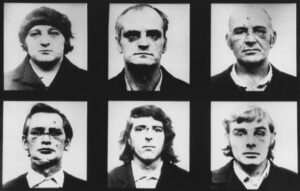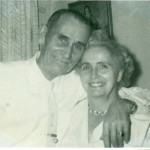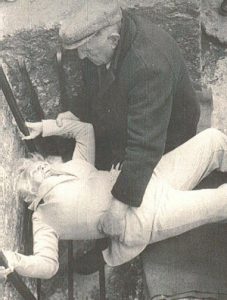irish
 On November 21, 1974, after two Irish Republican Army (IRA) bombs exploded in two separate Birmingham pubs, killing 21 people and injuring hundreds, an investigation was opened to find the culprits. Almost immediately, the investigation centered on six men, later known as the Birmingham Six. For years the IRA and the British government had been at odds over the status of Northern Ireland, in fact you had to be hiding under a rock if you didn’t know about it. Still, on that November day, it all came to a head. The bombs exploded, destroying everything and killing or hurting everyone in sight.
On November 21, 1974, after two Irish Republican Army (IRA) bombs exploded in two separate Birmingham pubs, killing 21 people and injuring hundreds, an investigation was opened to find the culprits. Almost immediately, the investigation centered on six men, later known as the Birmingham Six. For years the IRA and the British government had been at odds over the status of Northern Ireland, in fact you had to be hiding under a rock if you didn’t know about it. Still, on that November day, it all came to a head. The bombs exploded, destroying everything and killing or hurting everyone in sight.
The most immediate reaction of the British government was to outlaw the IRA. Virtually overnight, they were declared a terrorist group in all the United Kingdom. Thus began the worst miscarriage of justice in British history. Immediately, authorities rushed to arrest and convict the IRA members who were responsible for these horrific acts. Six Irish suspects were picked up. They were Hugh Callaghan, Patrick Joseph Hill, Gerard Hunter, Richard McIlkenny, William Power, and John Walker. During interrogation, four of the men signed confessions, which made no sense, because even the IRA, which had claimed responsibility for the Birmingham bombings, said that the six were not members of its organization.
That begs the question, that if the IRA claimed responsibility and specifically said these men were part of their organization, how could these men be tried, found guilty, and sentenced. Nevertheless, they were, and they  served 16 years before something was done about it. These men declared their innocence almost from the beginning…if you take the signed confessions at face value, and assume they were not coerced. The men stated and never wavered, that the police had beaten the confessions out of them. Many people would agree. Of course, the prosecutors denied this and also came up with forensic evidence that apparently proved that the Birmingham Six had handled explosives shortly before their arrest. It appeared that they just wanted to get a conviction so things could settle down. I’m sure they were under a lot of pressure to solve the crime.
served 16 years before something was done about it. These men declared their innocence almost from the beginning…if you take the signed confessions at face value, and assume they were not coerced. The men stated and never wavered, that the police had beaten the confessions out of them. Many people would agree. Of course, the prosecutors denied this and also came up with forensic evidence that apparently proved that the Birmingham Six had handled explosives shortly before their arrest. It appeared that they just wanted to get a conviction so things could settle down. I’m sure they were under a lot of pressure to solve the crime.
Following their convictions, the men were sentenced to lengthy prison terms. In all they spent 16 years in prison, before something changed. I’m sure they thought they would never be free again, but their convictions were declared “unsafe and unsatisfactory” and quashed by the Court of Appeal on 14 March 1991. Apparently, this all came about as a result of the widespread questioning of their guilt by the British people. They started seeing that things just didn’t add up, and yet, here were these men, locked up and seemingly innocent of any crime. In the face of all this, the British authorities released the so-called “Birmingham Six.” The six Irish men who had been sent to prison 16 years earlier for the 1974 terrorist bombings of two pubs in Birmingham, England. To further prove the error, in 1985, the forensic evidence was exposed by scientists as unreliable at best!! The nightmare for the Birmingham Six was coming to an end, and the nightmare for the British government was just beginning. In 1987 an appeals judge conceded that the same results could be obtained  from testing people who recently touched playing cards or cigarette paper, and yet these men were convicted of a bombing based on that same lack of credible evidence. Even with all that information, it took until March 1991, before the people across Britain and Ireland began calling for their release. Finally, they were freed after years in prison. They were free, but their story didn’t end there. Seven years later, a British court of appeals formally overturned their sentences, citing serious doubts about the legitimacy of the police evidence and the treatment of the suspects during their interrogation. The six men were later awarded compensation ranging from £840,000 to £1.2 million.
from testing people who recently touched playing cards or cigarette paper, and yet these men were convicted of a bombing based on that same lack of credible evidence. Even with all that information, it took until March 1991, before the people across Britain and Ireland began calling for their release. Finally, they were freed after years in prison. They were free, but their story didn’t end there. Seven years later, a British court of appeals formally overturned their sentences, citing serious doubts about the legitimacy of the police evidence and the treatment of the suspects during their interrogation. The six men were later awarded compensation ranging from £840,000 to £1.2 million.

 Saint Patrick’s Day…a day to celebrate being Irish. For me, Saint Patrick’s Day always felt like a borrowed holiday…probably because I don’t live in Ireland. The reality is that while I don’t live in Ireland, I am part Irish…9% to be exact. With the Irish in my family history, I would have expected my percentage to be for that 9%, but the reality is that most families migrated around the world, and while a family might have been in a country for centuries, they may not have originated there. Nevertheless, I had and still have family who live in Ireland, so I guess that makes me enough Irish to make Saint Patrick’s Day as much my day as it is anyone else’s. In reality, it is a day to remember the patron saint of Ireland. Saint Patrick was a missionary who heralded the shift from paganism to Christianity in the fifth century, when he was in his 40s. Saint Patrick’s Day is celebrated on what is believed to be the anniversary of his death…March 17.
Saint Patrick’s Day…a day to celebrate being Irish. For me, Saint Patrick’s Day always felt like a borrowed holiday…probably because I don’t live in Ireland. The reality is that while I don’t live in Ireland, I am part Irish…9% to be exact. With the Irish in my family history, I would have expected my percentage to be for that 9%, but the reality is that most families migrated around the world, and while a family might have been in a country for centuries, they may not have originated there. Nevertheless, I had and still have family who live in Ireland, so I guess that makes me enough Irish to make Saint Patrick’s Day as much my day as it is anyone else’s. In reality, it is a day to remember the patron saint of Ireland. Saint Patrick was a missionary who heralded the shift from paganism to Christianity in the fifth century, when he was in his 40s. Saint Patrick’s Day is celebrated on what is believed to be the anniversary of his death…March 17.
It is traditional to wear green on Saint Patrick’s Day, but why is that? Legend has it that if you’re wearing the color green, the quintessentially Irish, fairy-like creatures called leprechauns won’t be able to see you. And if they can’t see you, they can’t pinch you. Interestingly, before Saint Patrick’s Day got started, leprechauns were known not for wearing green but red. These days, the leprechauns have begun to outsource pinching to the rest of the world, or maybe we just took it over. Even the Irish flag has green in it. It is deeply symbolic. The green represents the Irish Catholics, the orange represents the Protestants and the white represents peace between the two. The green itself is called “shamrock green.” And speaking of shamrocks, shamrocks are one of the national symbols of Ireland, and not without reason. St. Patrick himself used the green, three-leaf clover to teach the Irish about the Holy Trinity: one for the father; one for the son; and one for the Holy Spirit. The four-leaf clover is just a symbol of good luck, if you believe in luck. Personally, I prefer blessing over luck.

 When a large population of the Irish came to the United States in the mid-1800s, they wore the color green (as well as the Irish flag) as a point of national pride, further solidifying the relationship between the color green and the Irish…in the American imagination anyway. But lets face it, it’s really about the kid in all of us. Celebrating Saint Patrick’s Day with pinches and shamrock accessories might seem silly, but it can be a great way to spend a day being a little bit on the goofy side. Friendly pinches of those who are forgetful, and show up with no green, is a great way to spend that one day…often still cold and even snowy, having a little bit of silly fun. And then there is the green beer, the green Chicago river, and the green clothing, hair, and beards of our friends.
When a large population of the Irish came to the United States in the mid-1800s, they wore the color green (as well as the Irish flag) as a point of national pride, further solidifying the relationship between the color green and the Irish…in the American imagination anyway. But lets face it, it’s really about the kid in all of us. Celebrating Saint Patrick’s Day with pinches and shamrock accessories might seem silly, but it can be a great way to spend a day being a little bit on the goofy side. Friendly pinches of those who are forgetful, and show up with no green, is a great way to spend that one day…often still cold and even snowy, having a little bit of silly fun. And then there is the green beer, the green Chicago river, and the green clothing, hair, and beards of our friends.
 Like many avid genealogists, I find myself looking at my roots often. As Saint Patrick’s Day rolls around, I find myself contemplating my Irish roots. I’m sure there are more than I can begin to count, but I specifically know of the Shaw family. These are my grandmother, Harriett Byer’s ancestors. The thing that I find to be sad is that the records are not as extensive as I wish they were. My DNA connects me to this family, but the 1600s is as far as I have been able to trace. I suppose that many people would think that the 1600s is a long way back, but it is barely to the point of their immigration from Ireland to the United States. Even in America, the records aren’t well kept. I find it quite sad that some families are so meticulous in their record keeping, while others just weren’t.
Like many avid genealogists, I find myself looking at my roots often. As Saint Patrick’s Day rolls around, I find myself contemplating my Irish roots. I’m sure there are more than I can begin to count, but I specifically know of the Shaw family. These are my grandmother, Harriett Byer’s ancestors. The thing that I find to be sad is that the records are not as extensive as I wish they were. My DNA connects me to this family, but the 1600s is as far as I have been able to trace. I suppose that many people would think that the 1600s is a long way back, but it is barely to the point of their immigration from Ireland to the United States. Even in America, the records aren’t well kept. I find it quite sad that some families are so meticulous in their record keeping, while others just weren’t.
My Grandma Byer and her siblings were proud of their Irish roots. In their later years, they took a trip to Ireland to search for family information, graves, and living family members. I’m not sure if they found much  information, but without computers, information was harder to find then. It’s not that computers didn’t exist, but rather the simple fact that none of them knew how to use one. Nevertheless, they had a wonderful trip. They explored castles, town and villages, and they saw the amazing green fields that are synonymous of Ireland. They also did something that I have found interesting, when the had the opportunity to kiss the Blarney Stone. For those who don’t know about the Blarney Stone, “The Blarney Stone (Irish: Cloch na Blarnan) is a block of Carboniferous limestone built into the battlements of Blarney Castle, Blarney, about 8 kilometers (5 miles) from Cork, Ireland. According to legend, kissing the stone endows the kisser with the gift of the gab (great eloquence or skill at flattery).” It’s really just a goofy tradition, but I suppose it is a fun idea, and one they decided was worth testing.
information, but without computers, information was harder to find then. It’s not that computers didn’t exist, but rather the simple fact that none of them knew how to use one. Nevertheless, they had a wonderful trip. They explored castles, town and villages, and they saw the amazing green fields that are synonymous of Ireland. They also did something that I have found interesting, when the had the opportunity to kiss the Blarney Stone. For those who don’t know about the Blarney Stone, “The Blarney Stone (Irish: Cloch na Blarnan) is a block of Carboniferous limestone built into the battlements of Blarney Castle, Blarney, about 8 kilometers (5 miles) from Cork, Ireland. According to legend, kissing the stone endows the kisser with the gift of the gab (great eloquence or skill at flattery).” It’s really just a goofy tradition, but I suppose it is a fun idea, and one they decided was worth testing.
The big Saint Patrick’s Day parties are far more an American tradition than it is as Irish one. In fact, people might be surprised at the real background of the day. Saint Patrick’s Day was made an official Christian feast day in the early 17th century and is observed by the Catholic Church, the Anglican Communion (especially the Church of Ireland), the Eastern Orthodox Church, and the Lutheran Church. In reality, It is a day that  commemorates Saint Patrick and the arrival of Christianity in Ireland. It also celebrates the heritage and culture of the Irish in general. Celebrations generally involve public parades and festivals, cèilidhs (a social event at which there is Scottish or Irish folk music and singing, traditional dancing, and storytelling), and the wearing of green attire or shamrocks. Some Catholic Christians also attend church services and historically in Ireland the Lenten restrictions on eating and drinking alcohol were lifted for the day, which is likely where the holiday’s tradition of alcohol consumption came from. So, whether you celebrate in the tradition of America or the tradition of Ireland, Happy Saint Patrick’s Day to one and all.
commemorates Saint Patrick and the arrival of Christianity in Ireland. It also celebrates the heritage and culture of the Irish in general. Celebrations generally involve public parades and festivals, cèilidhs (a social event at which there is Scottish or Irish folk music and singing, traditional dancing, and storytelling), and the wearing of green attire or shamrocks. Some Catholic Christians also attend church services and historically in Ireland the Lenten restrictions on eating and drinking alcohol were lifted for the day, which is likely where the holiday’s tradition of alcohol consumption came from. So, whether you celebrate in the tradition of America or the tradition of Ireland, Happy Saint Patrick’s Day to one and all.
 We all have within our DNA, a mix of nationalities, and with that, I think most of us have a little Irish in the mix. I know that in my own roots, you would find Irish ancestors from both sides, and I’m pretty sure Bob’s family is the same. A short time after my grandfather passed away, my grandfather and her sisters and brothers had the opportunity to travel back to Ireland to see the old country and meet some of the family from Ireland. It would be a trip she would remember for the rest of her life. She got to see the castles, kiss the Blarney Stone, and see the green, green hillsides. She got to see where all tradition started. I wish I could have gone along with her. What a trip that would have been.
We all have within our DNA, a mix of nationalities, and with that, I think most of us have a little Irish in the mix. I know that in my own roots, you would find Irish ancestors from both sides, and I’m pretty sure Bob’s family is the same. A short time after my grandfather passed away, my grandfather and her sisters and brothers had the opportunity to travel back to Ireland to see the old country and meet some of the family from Ireland. It would be a trip she would remember for the rest of her life. She got to see the castles, kiss the Blarney Stone, and see the green, green hillsides. She got to see where all tradition started. I wish I could have gone along with her. What a trip that would have been.
While I have never been to Ireland, I do have something in my own life that in name only gets its roots from Ireland…Irish Twins. What, you might ask are Irish Twins? Irish Twins are siblings born either in the same year or within 12 months of each other. My daughters, Corrie and Amy were born 11 months apart. My guess is that you know some of these yourself. I know that I have cousins who are also Irish Twins. In fact, my cousins. Susie and George are Irish Twins. While Irish Twins may not have any real ties to Ireland, it is something that I think is very cool.
So, today we celebrate that bit o’ the old country that most likely resides in each of us. Whether you  party at the pub, drinking green beer, or make sure that you are wearing something green, so as not to be pinched, most of us will celebrate the day in one way or another. It’s not that it is what we would consider a big holiday, but rather a fun holiday…one for goofiness, partying, and as my younger Irish Twin would say, a day to “Kiss me…I’m Irish.” It began however as a Christian holiday. It is also an Irish holiday. So how are the two related? Well, St Patrick’s Day was the day that Christianity came to Ireland…so maybe it should be a bigger holiday that we have made it. So, however you choose to celebrate it, I just want to tell everyone Happy St Patrick’s Day!!
party at the pub, drinking green beer, or make sure that you are wearing something green, so as not to be pinched, most of us will celebrate the day in one way or another. It’s not that it is what we would consider a big holiday, but rather a fun holiday…one for goofiness, partying, and as my younger Irish Twin would say, a day to “Kiss me…I’m Irish.” It began however as a Christian holiday. It is also an Irish holiday. So how are the two related? Well, St Patrick’s Day was the day that Christianity came to Ireland…so maybe it should be a bigger holiday that we have made it. So, however you choose to celebrate it, I just want to tell everyone Happy St Patrick’s Day!!
 Ah, here it comes…the wearin’ of the green, corned beef and cabbage, and green beer for those who like that…Saint Patrick’s Day. It’s a day for partying…and pinching for those who forget to wear green. Most people look at Saint Patrick’s Day as just another party day. And I enjoy the pinching games and the corned beef and cabbage, but I’ll leave the green beer for others.
Ah, here it comes…the wearin’ of the green, corned beef and cabbage, and green beer for those who like that…Saint Patrick’s Day. It’s a day for partying…and pinching for those who forget to wear green. Most people look at Saint Patrick’s Day as just another party day. And I enjoy the pinching games and the corned beef and cabbage, but I’ll leave the green beer for others.
One thing that Saint Patrick’s Day does make me think of, however, is my Irish background. I think most of us have a little Irish background, and some have a lot. You can usually find it by the last names, like Bob’s grandmother, whose name before her marriage was Leary, or my great grandmother, whose maiden name was Shaw. Many of these ancestors really never knew very much of their Irish roots, because their families have been in the United States for centuries. I don’t remember either of these grandmothers ever mentioning Irish roots, or being particularly Irish.
Still, many people whose Irish traditions, or any other traditions common to their countries,  have been passed down from generation to generation, feel a deep attachment to the past and to their roots. Anytime you look back at your family history, you can’t help but feel the beginnings of an attachment to a different time and a different place. It’s easy to envision what life might have been like then. Days before cars and planes, when people traveled by horse and buggy. Days when moving to a new country meant leaving your family behind forever…never to see them again.
have been passed down from generation to generation, feel a deep attachment to the past and to their roots. Anytime you look back at your family history, you can’t help but feel the beginnings of an attachment to a different time and a different place. It’s easy to envision what life might have been like then. Days before cars and planes, when people traveled by horse and buggy. Days when moving to a new country meant leaving your family behind forever…never to see them again.
Travel wasn’t so easy then. And yet brave people like our ancestors, who wanted to have a better life, set out into the unknown. They had no idea what they would find out there, but they set aside their fears and went anyway. They were pioneers, and were it not for them, we would not be where we are today, or have what we have today. They are also the inventors. Someone had to come up with all of the modern conveniences that we have today. They were people with that same pioneer spirit. What would our world be like without those people and people like them. People who  carried their traditions into a new world, or people who came to the new world and started traditions of their own.
carried their traditions into a new world, or people who came to the new world and started traditions of their own.
Much of my background is German and English, but there is some Irish, and the Irish family members that I have had the pleasure of knowing were very much a treasure as valuable as the emerald colored hills of the old country. So I’ll carry on the tradition today. Wearin’ the green, and pinching those who forget, and eating corned beef and cabbage with loved ones. Because, today…everybody is a little bit Irish. Happy Saint Patrick’s Day to all.

